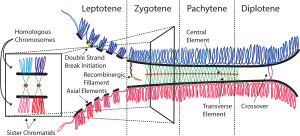

The synaptonemal complex (SC) is a protein structure that forms between homologous chromosomes (two pairs of sister chromatids) during meiosis and is thought to mediate synapsis and recombination during prophase I during meiosis in eukaryotes. It is currently thought that the SC functions primarily as a scaffold to allow interacting chromatids to complete their crossover activities.[1]
- ^ Page SL, Hawley RS (2004-10-08). "The genetics and molecular biology of the synaptonemal complex". Annual Review of Cell and Developmental Biology. 20 (1): 525–58. doi:10.1146/annurev.cellbio.19.111301.155141. PMID 15473851.